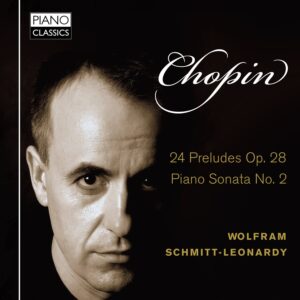In his recording of Chopin’s 24 Preludes, Wolfram Schmitt-Leonardy achieves a fusion of impassioned ardor and classical textual rigor that is immediately evident in No. 1’s subtle changes in voicing and ample ritards. Schmitt-Leonardy highlights No. 2’s jarring dissonances and spices up No. 3’s suave surface of left-hand arpeggios with sharply accented right-hand upbeats. The pianist manages to project an even, long-lined trajectory in No. 4, yet close listening reveals that not one bar is exactly in the same tempo.
By taking seriously Chopin’s indications for using and abstaining from the sustain pedal, Schmitt-Leonardy uncovers No. 5’s intricate cross-rhythms, along with unusual inner voices. The broadly sustained No. 6 contains more pronounced than usual dynamic contrasts between the hands. By pedaling through the rests, Schmitt-Leonardy implies that each of No. 7’s phrases begins on a downbeat, rather than the preceding upbeat as marked (Pollini’s first recording gets this detail right). However, No. 8 is a winner with its beautifully sculpted textural layers, where even Schmitt-Leonardy’s reversed dynamics and occasional left-hand anticipations sound authentic. So does No. 9’s slightly animated tempo and unusual stress of the left-hand dotted rhythms.
No. 10’s flickering runs may not match the light and supple leggero touch of Moravec or Argerich, yet Schmitt-Leonardy’s emphatic articulation helps make their alternating triplet and duplet rhythms distinct. He takes No. 11’s Vivace marking at face value, and wisely tempers Chopin’s uniform legato directive with a few tellingly placed detached phrasings. No. 12’s syncopated phrase groupings read well here, although not to the revelatory effect of Alexandre Tharaud’s scrupulous pedaling and unusual emphasis of the middle section’s Mazurka allusions. Schmitt-Leonardy’s intensity somewhat neutralizes in the lyrical Nos. 13, 15, and 17, but No 14’s unison octaves generate dynamism and harmonic tension. Playful accents and discreet pedal effects help enliven No. 16’s virtuosic assurance and élan.
Schmitt-Leonardy’s performance of the melodramatic No. 18 is remarkable. He is one of the few pianists to play the unison octave lines in tempo so that one can perceive the metrical distinctions between measure seven’s 16 even notes and measure eight’s tuplet of 22 notes in the time of 16. He also brings out the rarely observed diminuendos before the sforzando chords. Furthermore, the pianist underlines the final bars’ dramatic intensity by playing measure 18’s fortissimo 16th-note triplets strictly in tempo with the dry, biting staccato that Chopin indicates, then courageously waiting out those often shortchanged five beats of rest preceding the final two chords.
Following a measured and ample-toned No. 19, No. 20 unfolds a bit faster than expected, although a small, miscalculated diminuendo on measure five’s last beat telegraphs the sudden drop to piano at measure five. A genuine dialogue between the hands helps to justify No. 21’s expansive and flexible tempo. In No. 22, I applaud Schmitt-Leonardy’s decision to underplay the fortissimo left-hand repeated-note octaves in order to better clarify the right-hand chords’ difficult-to-execute diminuendos. If No. 23 is slightly too loud and square next to its more poetic and supple competitors, No. 24’s big-boned profile and golden tone evoke Arrau’s similarly majestic performance.
Schmitt-Leonardy’s account of the B-flat minor sonata is not so consistently persuasive, yet many details beckon your attention, not the least of them being the first movement’s terse expressive economy and unusual exposition repeat that recapitulates the Grave introduction—a more plausible and harmonically logical alternative to the score’s repeat sign at the Doppio movimento. In the Scherzo I’m not quite sold on Schmitt-Leonardy’s overly stretched out Trio section, while his slight broadening of tempo for the outer sections’ treacherous chord/octave skips seems to be a decision borne out of risk aversion.
The Funeral March is grippingly slow and rock steady, and astute listeners will pick up on the unusual, almost stabbing effect of the low-register trills (measures 19 and 20 and elsewhere) as they begin on the downbeats rather than anticipating the measure as we often hear. While the celebrated “wind over the grave” Finale is not particularly fast (it’s more of a Molto allegro than a Presto, to my ears at least), you cannot help but notice Schmitt-Leonardy’s fanciful yet musically illuminating phrase groupings and accentuations, not to mention his added bass octave on the final measure’s B-flat downbeat. In sum, the best of Schmitt-Leonardy’s Chopin adds up to a stimulating and compelling listening journey well worth traveling, even if you’ve heard these works hundreds of times.
































